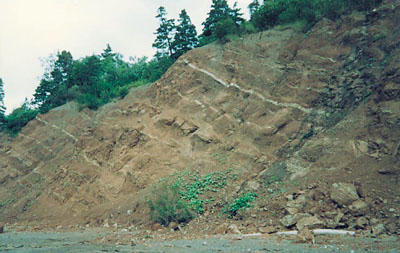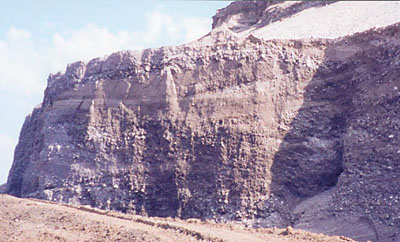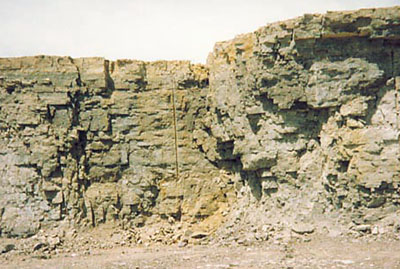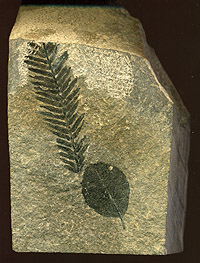 | |||||
| About Us | Contact Us | Services | Copyright | |||||
|
|||||
|
Sedimentary Rocks By Marilyn Fraser
Sedimentary rocks are formed from sediments, just as the name says. Only 5 per cent of the Earth's crust consists of sedimentary rocks, yet 75 per cent of the rocks exposed at the Earth's surface are sedimentary. Weathering wears down the other rocks into silt and rain and rivers wash the silt down and deposit it in layers. That is one way to identify sedimentary rocks – you can see layers in the rock (Figure 1). Most fossils are found in sedimentary rock – in sandstone and coal for example.
WeatheringRocks at the Earth's surface are subject to weathering by the chemical action of acid and alkali salts in rain and ground water. They are also broken down mechanically. Expanding ice, and alternate heating and cooling crack the rocks. This allows water to get in the cracks and when the water freezes in winter the expanding force is so great that the rock can shatter.Plant roots break up the surface of a rock allowing water to penetrate the cracks. This water helps the chemical breakdown of rocks. Frost shattering is a major processes of mechanical breakdown and is responsible for the accumulation of angular rock fragments, known as scree deposits, at the foot of steep mountain slopes. In hot deserts, rocks can fracture as they expand during the heat of the day and contract during the cold night. Tunnel walls in a mine can collapse with explosive force because of the pressure of the surrounding rock. This happens to some extent at the Earth's surface. Many rocks that are now exposed were once buried under great masses of overlying layers of rock. Once the overlying rocks have been removed by erosion, the release of pressure can cause fractures parallel to the rock surface. These fractures are known as sheet joints.
TransportationOnce the rock has been weathered, the material – silt – may be moved by transport. This is not a big truck! It can be a stream of water that can transport undissolved particles by bouncing them along the stream bed. This is known as saltation; if the particles are small enough, they may be carried in suspension. A mountain stream in spring is often opaque and milky with suspended sediment.Another transport method is by wind. Occasionally, very fine dust gets carried high into the atmosphere and is carried great distances. Red dust from the Sahara sometimes travels as far as Britain and northern Europe to coat windows and cars. Wind can also transport particles by saltation along the ground and in suspension as dust.
DepositionWeathered rock can be deposited as a sediment by three processes:
CoalCoal is a sedimentary rock, that is not formed from minerals or other rocks. It is a special case because it is formed from vegetable material – trees, ferns, plants of any kind – that has been buried in a swamp or by flooding that buries it in mud. As time passes, the material gets buried deeper. A lot of pressure and heat are put on this material the deeper it is buried. Finally, this material becomes rock formed from the carbon in the vegetable matter. Coal often shows fossil patterns of ferns and leaves from the original plants.The final sediment may consist of one or more of the above three processes.
FossilsFossils form in sedimentary rock when an animal or plant becomes buried in mud or sand before it is eaten or before it rots. If air is excluded, such as it would be in thick mud, over thousands of years the bones turn to stone by absorbing and exchanging minerals with the surrounding soil and water. This would produce a fossil. Or the plants would leave an impression, an imprint, such as you frequently see in lumps of coal (Figure 4).From these fossils and impressions in sedimentary rock, we can tell what kind of plants and animals lived at a certain period in the very ancient past.
Why are sedimentary rocks important?Sedimentary rocks are important economically because they contain useful minerals and provide reservoirs for water, oil, and gas. Their formation is of interest too, because many of the processes by which they are laid down can be seen at the Earth's surface today.Sedimentary rock is always used to see what happened in the past. Different types of sedimentary rock can tell us different things about what the land and sea were like in the past, thousands and millions and billions of years ago. Types of sedimentary rock:
This article may not be copied, distributed or reprinted in any form without the author's permission. To contact the author, please use the e-mail address provided. If you are unable to contact the author, please contact the Canadian Rockhound. Authorized reprints must acknowledge the author, original source and the Canadian Rockhound, and include the website URL address of the Canadian Rockhound.
|
||||

Copyright © 2000 Canadian Rockhound
Magazine Issues |
News & Events |
Junior Rockhound |
Resources
|
||||



